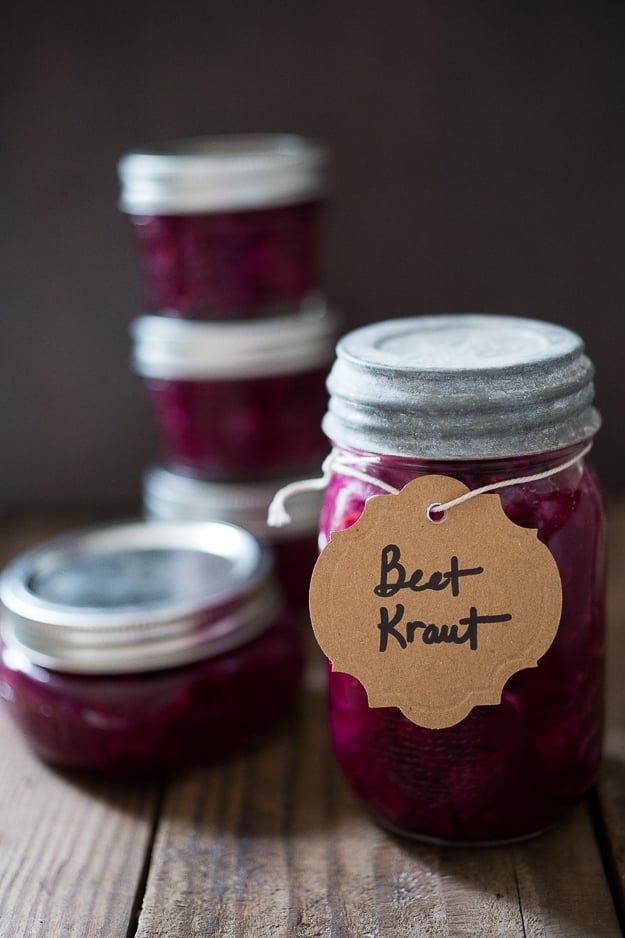
In this recipe, I use purple cabbage and grated beets, which give it this beautiful vibrant color. But feel free to use just cabbage if you prefer. The refreshing bite is such a welcome accompaniment to dinner, especially with heavier meals, providing good contrast in texture and flavor. It’s also delicious on sandwiches, in tacos, wraps or have a bowl of it on its own. And you really don’t need any special equipment to make this…. a mason jar works just as well as a crock.
For the love of Beets!
Not only are beets earthy, sweet and full of flavor, but beets are also a nutritional powerhouse! They are full of incredible antioxidants, beets can lower blood pressure and reduce inflammation. If you looking for new ways to incorporate beets in the kitchen, take a look at our 20 Best Beet Recipes– you’ll find some delicious inspiration here!
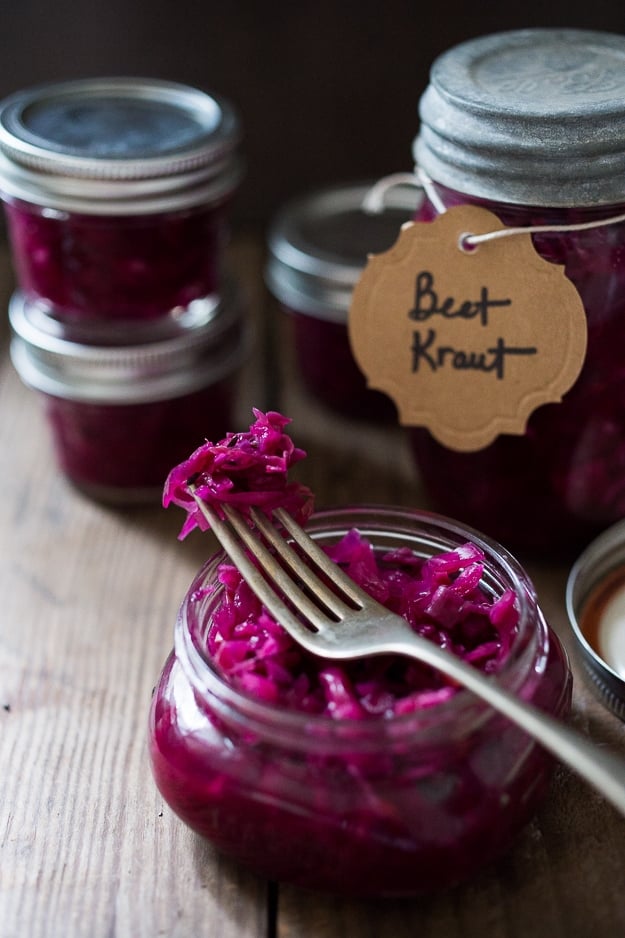
Benefits of Fermented Sauerkraut
The main reason I am in love with homemade kraut is it’s incredibly good for our bodies. The simple fermentation process creates healthy bacteria, that have amazing cancer-fighting and immunity-building properties, similar to the healthy probiotics in yogurt, but without dairy and fat. As cabbage ferments, it produces living bacteria that give our microbiome diversity!
These good bacteria, or “probiotics” help boost our whole immune system, keeping us healthy and better able to ward off illnesses.
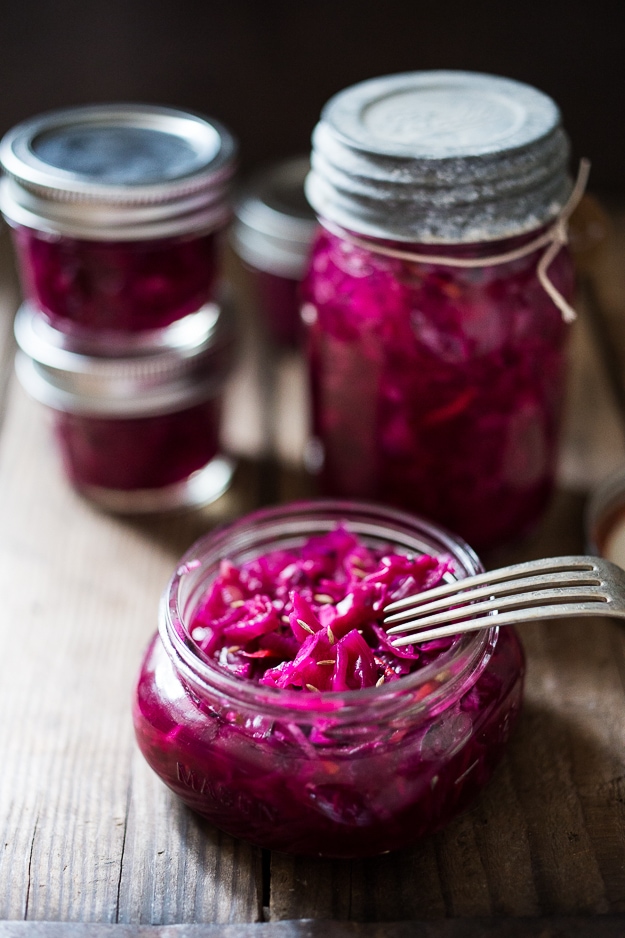
But if you eat sauerkraut that has been pasteurized (the store-bought kind, canned and not refrigerated) the heat in the pasteurization process actually kills these good live bacteria, and so we won’t benefit from the probiotics…and that’s why I like to make it at home.
Plus it’s SO easy, and you can flavor it however you like.
Beet & Cabbage Kraut Ingredients
- organic purple cabbage ( or green cabbage)
- organic red beet ( or golden beets)
- onion, garlic or ginger- all optional
- mineral salt or sea salt, do not use iodized salt or kosher salt
- optional: caraway seeds, herbs.
How to make Beet Sauerkraut
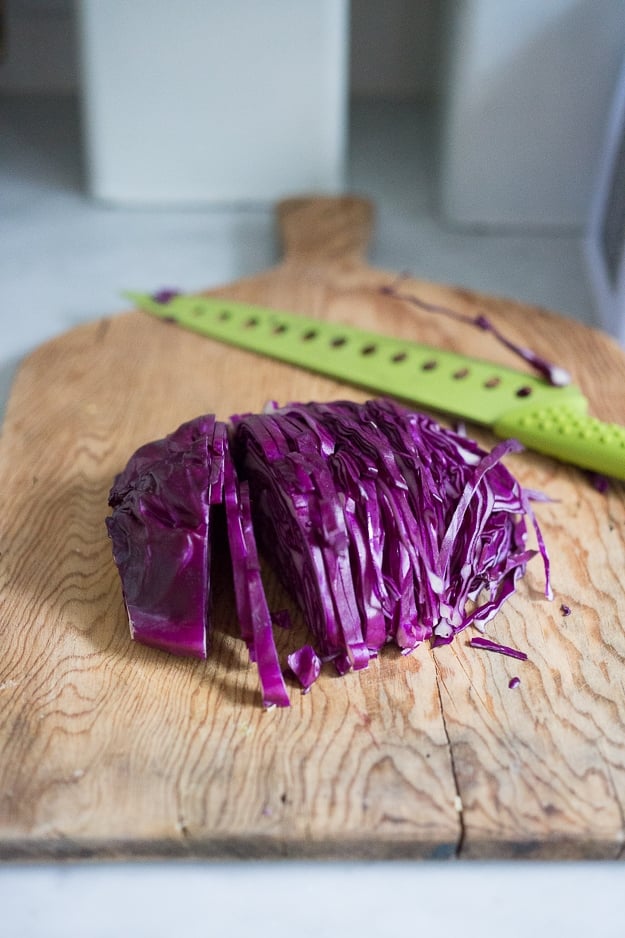
Step one: Finely slice and grate cabbage and raw beets.
I like to add a ⅛ to ¼ cup of sliced onion, and sometimes minced garlic. This is optional. It will make the smell slightly off-putting as it ferments, but once it’s refrigerated, it adds a really delicious flavor.
Step two: Weight the cabbage-beet mixture in grams. Multiply this by .02. This is the amount of salt you will need in grams. ( See recipe notes) Measure out the salt.
Step three: Massage the cabbage-beet mixture with the salt. Let it sit in the bowl on the counter, occasionally mixing for a 1-2 hours. Add caraway seeds if you like, or a little grated ginger.
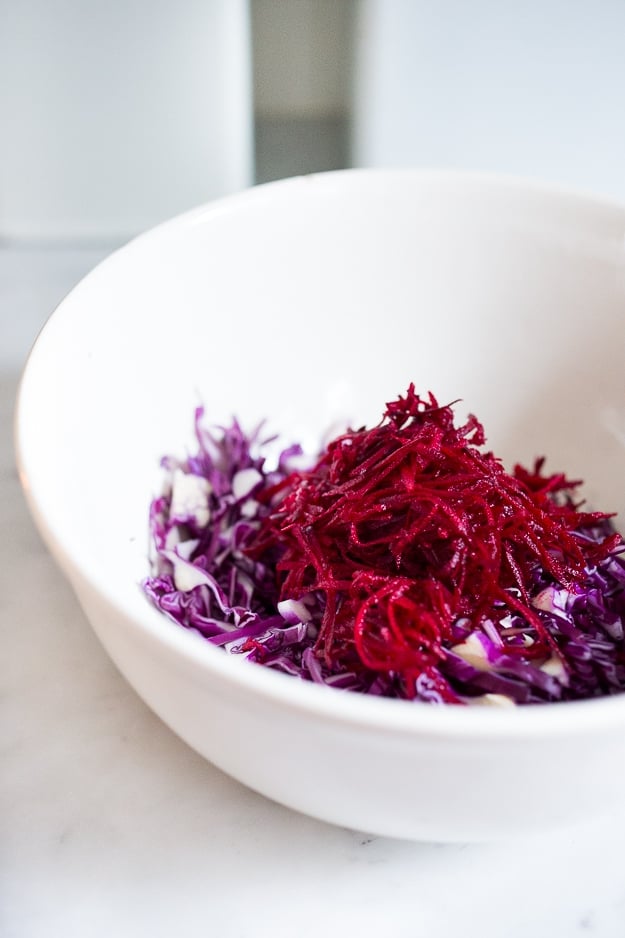
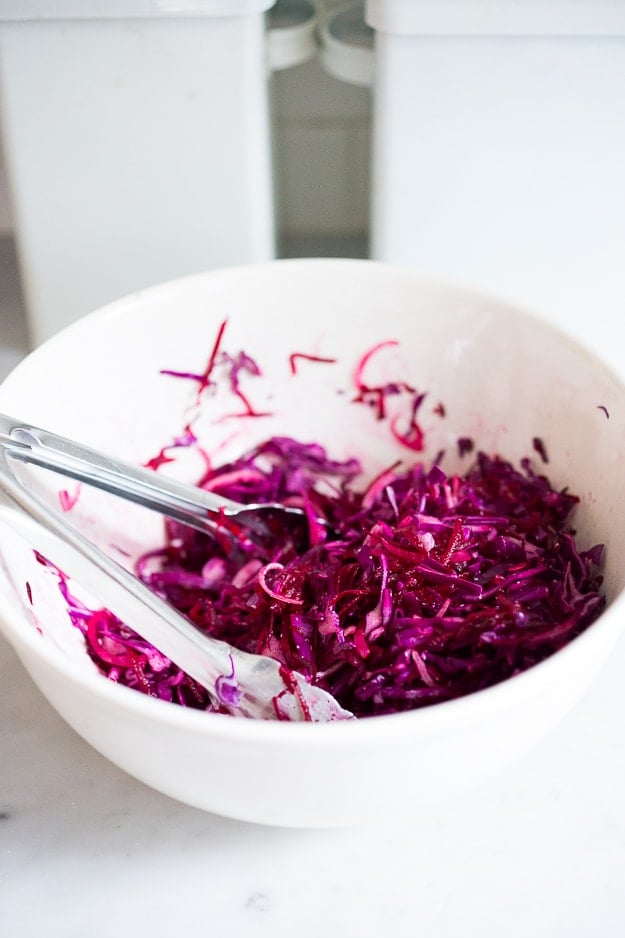
Step 4: Place the cabbage mixture along with all the juices in clean mason jars, and pack it down with a muddler or the end of a wooden spoon. Cover it with a cabbage leaf. Pack it down once more so cabbage is under the brine.
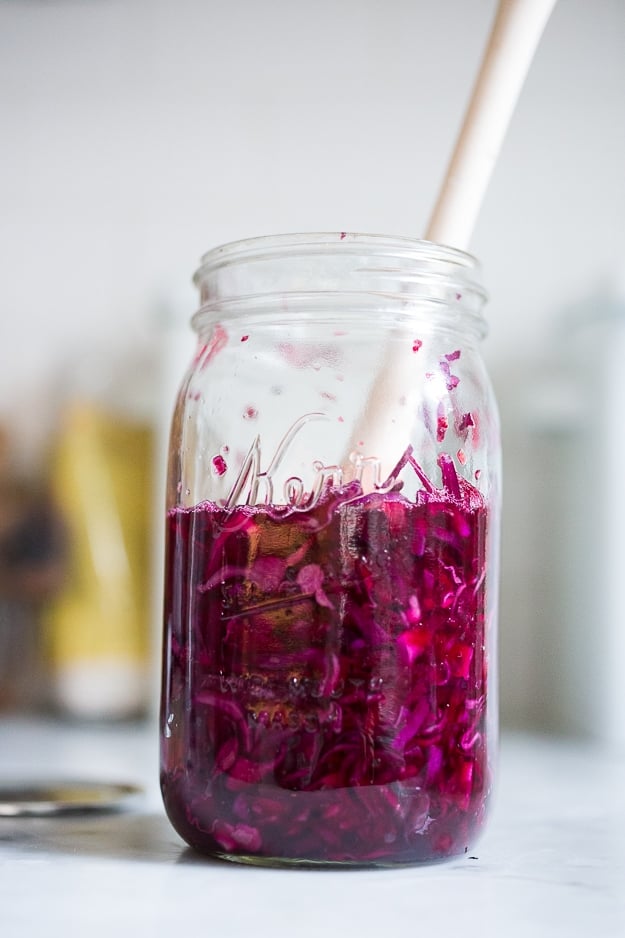
Step 5: Then leave it on the counter, with the cabbage weighed down ( see notes) and covered loosely with a lid, over a plate or pan to catch any juices, with a dishcloth placed over it (or place somewhere dark and cool, ideally 65- 72 degrees F) for 3-5 days, or longer if you prefer more fermentation, occasionally pressing down on the cabbage.
My personal preference is 4-5 days at 65F for a refreshing and crunchy version. After a few days, you should start to see some activity, bubbles, with you tap the jar.
Step 6: Refrigerate. After 3-7 days, close it with a lid and put it in the fridge…and don’t worry, it will smell better once it is chilled. Once it chilled, it’s ready to eat. As it rests in the fridge, it will continue to ferment but at a much slower rate. It will taste better and better.
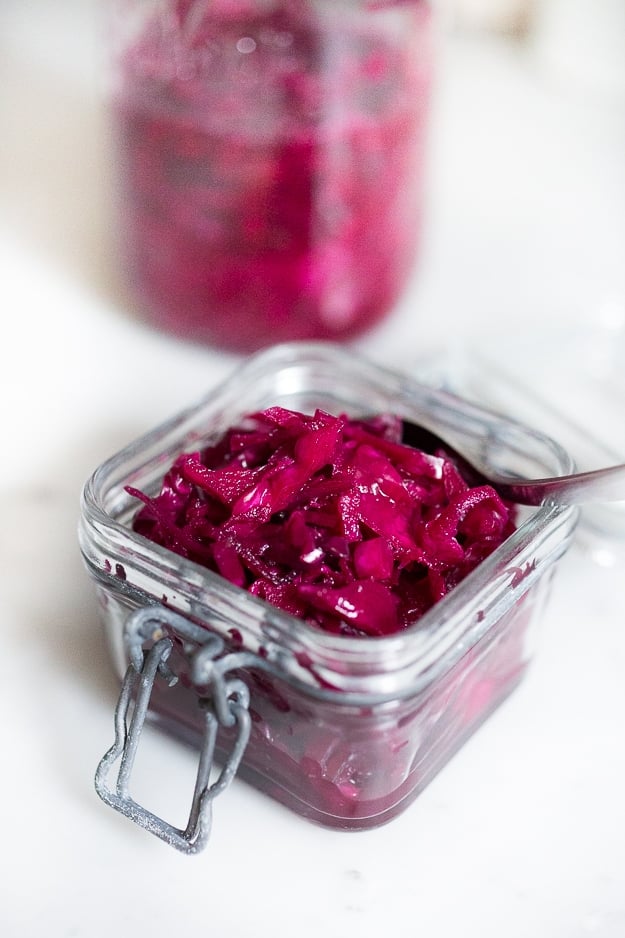
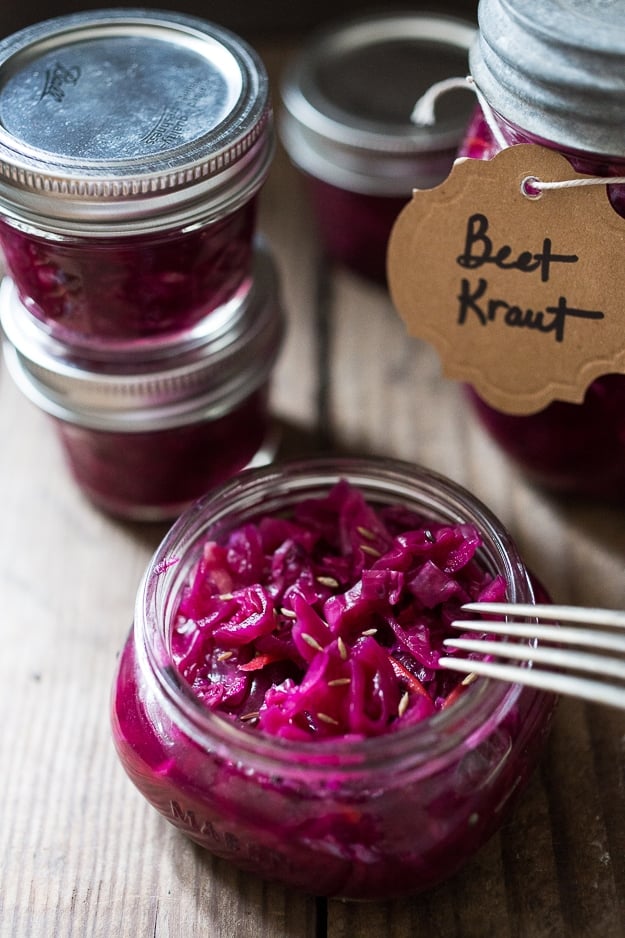
More recipes you may like:
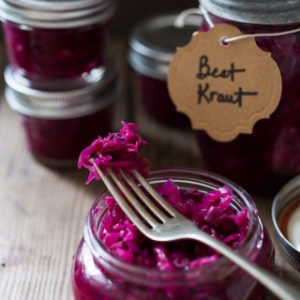
Beet and Cabbage Sauerkraut
- Prep Time: 20 mins
- Total Time: 20 mins
- Yield: 4 cups 1x
- Category: sauerkraut
- Method: fermented
- Cuisine: Preserving
- Diet: Vegan
Description
A simple easy, small-batch recipe for Beet and Cabbage Sauerkraut that anyone can make using a mason jars. Full of good healthy bacteria! Allow 5 days fermenting time!
Ingredients
- 1 small red cabbage- finely sliced (save a couple whole leaves , for the top)
- 1 cup grated raw beet- do not peel.
- 1/8–1/4 cup sliced red onion – optional
- mineral salt or sea salt (you will calculate)
Other optional ingredients:
- 1 teaspoon caraway seeds
- 1 garlic clove, sliced
- 1–2 teaspoons grated ginger
Instructions
- Place a medium bowl on a scale and zero out the scale, leaving the bowl there.
- Finely slice and grate cabbage and beets and place in the bowl. Add garlic, onion and or ginger if using.
- Weigh the cabbage in grams- careful not to include the bowl weight. Multiply the cabbage amount by .02. This is the amount of salt in grams you will need ( see notes). Zero out the scale again, with the filled bowl, and add the calculated salt.
- Massage the with the salt, Let sit on the counter, mixing occasionally for 1 hour, until cabbage has wilted and released a little water.
- Place cabbage beet mixture and all the juices in a CLEAN mason jars and pack it down with a muddler, or the end of a wooden spoon, leaving 2-3 inches at the top. Place a couple of cabbage leaves over the kraut to help keep it submerged under the liquid along with a fermentation weight.
- If there is not enough liquid to cover, mix one teaspoon sea salt with 1 cup of filtered water, and add just enough of this brine so cabbage-beet mixture is submerged- leaving at least 2-inches space at the top of jar. If any seeds or particles float to the top, remove them with a slotted spoon. Anything that is not completely submerged can mold. Cover loosely with a lid and place on a pan ( to catch any liquid).
- Place in a cool dark place ( ideally 65 -72 degrees F ) for 3-5 days. It may take longer to ferment if it is colder. I often place mine in the cooler part of my kitchen, covered with a big dishcloth. You can check it daily to make sure the cabbage is under the brine.
- After 3-4 days, check for activity. When you tap the jar, tiny bubbles should rise to the top, indicating it’s fermenting. Once fermented to the desired amount, add the caraway seeds and place it in the fridge. The longer it ferments the sourer it will taste.
- Once it’s chilled the smell will surprisingly mellow out and it will actually seem edible! So let it chill overnight, discard the cabbage leaf, then give it a taste!
Notes
Salt Ratio: The recommended salinity for Sauerkraut is 1.5% – to 2.5% salt to the weight of the cabbage. Here we use 2% salt to the weight of the cabbage. Example: 1ooo grams cabbage multiplied x .02= 2o grams of salt. Feel free to use more or less as long as it stays between 1.5% and 2.5%. I use Himalayan Sea Salt and Real Salt. Both are natural and unrefined with high mineral content.
Cabbage: Use organic cabbage if possible. Do not use pre-shredded cabbage. You need the natural bacteria from a whole cabbage. Farmers’ market cabbage works especially well.
Use a fermentation weight to keep the kraut submerged or something small and clean that will fit inside the jar, like a small shotglass.
Nutrition
- Serving Size: 1/4 cup
- Calories: 45
- Sugar: 3.4 g
- Sodium: 670.6 mg
- Fat: 0.2 g
- Saturated Fat: 0 g
- Carbohydrates: 10.2 g
- Fiber: 2.1 g
- Protein: 2 g
- Cholesterol: 0 mg
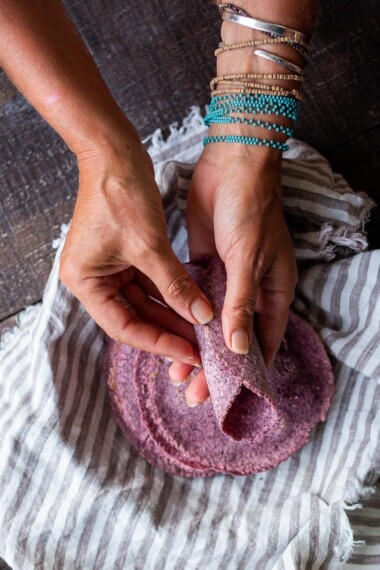
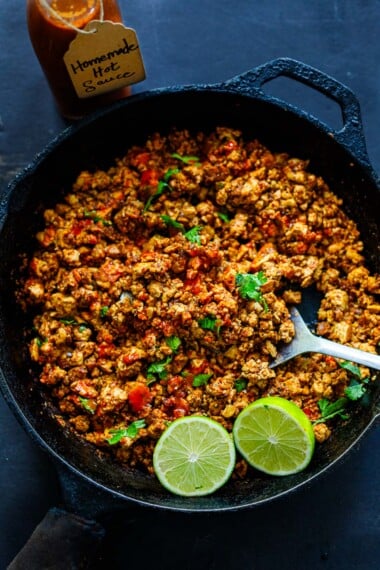



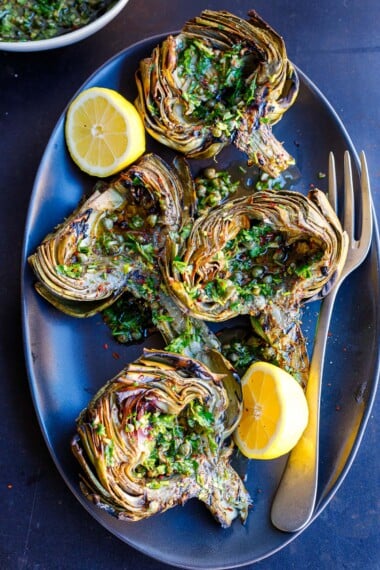
Ooops! I carelessly added the caraway seeds into the mixing bowl at the initial stage. Got a bit over-excited!! Have I ruined it?
It should be just fine!
Looking forward to trying this recipe – but I’m stumped on the method for measuring salt. Can the amount of salt used be measured in teaspoons or tablespoons? Also, can fermentation take place with lower salt quantities? Thanks!
Hey Sarah, I would use at least 1 ½ teaspoons per pound of cabbage. A medium cabbage is roughly 2 lbs. Any lower and you risk bad bacteria growing. Weighing is really the best method for safety here. 🙂
Fabulous recipe!!!!!! Thank you so much!!!!
Awesome Connie! So happy it worked out for you.
Have made this recipe a few times it’s delicious
Great to hear Rhian!
This looks great, I used some purple cabbage stored from my garden and beets too, at the last minute I decided to add fresh horseradish root thinking of a relish I used to make with cabbage, beets and horseradish
Perfect Barb! Sounds tasty!
It doesn’t say if the par boil the beet
Hi Orit- use raw unpeeled beets here.
I’ve made sauerkraut with cabbage and beets very successfully. Beats in my area are outrageously expensive four dollars a pound!!! Is it possible to use canned beets as a substitute for fresh?
Canned beets do not have any living bacteria on them so not good for fermenting. You could increase the cabbage and decrease the beets to save a little money?
Thanks for the good kraut recipes! I made the turmeric kraut and this one at the same time by dividing one cabbage. I opted to add garlic, didn’t quite use a cup of beets, and added some brine to cover. Ended up with a wonderfully tangy and tasty magenta kraut that has more than a hint of horseradish flavor. I’ll add the full amount of beets next time, and likely use red cabbage for full color excitement. Do you think you could work up a garlic dill kraut recipe similar to what Farmhouse Culture sells? (Will test the Curtido soon as well.)
I think you could take our Cultured Kraut and add garlic and dill to it- it would come very close!
Thank You so much for the excellent recipe. This is easy and works great with fish tacos! A big hit with the entire family. I just did the basic recipe with no other optional ingredients and let it sit for 4 days. It was nice a crisp…going to try the next batch with some of your optional ingredients
Thanks Bob! Love that you served with fish tacos. You should also take a peek at Curdito, the Salvadoran Slaw ( also fermented).
Miss Sylvia,
Wow. You hit at the heart of me w this. Memories of pork hocks and sauerkraut or a creamed kolrabi dish, and of course anythg cabbage related. Nana wld shred cabbage for a salad instead of lettuce way back when. I BELIEVE w all my heart and soul, the “olden days” were the golden days. Family being second after a bowing of heads in prayer to God for the food we ate and all His blessings and mercy. Life is good because it can be good!
Question for you (or anyone experienced making this type of recipe), do you rinse/clean your vegetables with water prior to starting the cutting process? Or will rinsing remove some of the beneficial bacteria? thanks in advance for any feedback. i plan to get started this weekend!
Don’t rinse. 🙂
Hi There, The only thing I am stumped on is the size of the mason jar to use. Can you fill me in please?
I had the same question. I have either small jars or a jar that is too big. Did you find any helpful info?
I would use the bigger jar, – you don’t need to fill it all the way up.
I use two 24 oz. straight sided Ball jars for this recipe. It is easier to keep cabbage submerged.
Hi Sylvia,
Your guidance is the simplest. The introduction allayed my fears. Guess what? I v made such yummy cabbage and saukrat with 2 garlic cloves and today is the 3rd day.No mould,no browning.All intact ,slightly tangy and flavourful and crunchy. Thanks also on the warning to put the fermenting bottle in a plate / container to trap spills. It actually spilled the next day and it would v been a mess with out d plate.Now I v turned it out into a plastic container with a cover and kept in the fridge. Does plastic container affect it? I will be taking out some everyday for use. I hope constant opening will not affect it.
Thank you once again
Awesome, thanks so much and glad you like it! 🙌 I prefer glass or ceramic- not sure if plastic affects fermentation, but I don’t like to leave things in plastic because it can leach into your food.
Looks amazing! I will try it … one question… can I use pink Himalayan salt in place of sea salt?
Yes, totally!
I put this in the fridge after three days it was quiet bubbly, and strong smelling.. but once is mellowed it didn’t taste very sour. Can I take it out and continue to ferment?
Thanks 😊
I don’t see why not? Give it a try.
I am going to make this today, good idea with the beetroot. I will also add juniper berries and bay leaf.
Sounds tasty!
Good idea. I will try it myself too
Good idea. I will try it too
I made this but when I put it in jars in the fridge, it kept fermenting. What did I do wrong?
This is what it does- it keeps fermenting. Sounds perfect, nothing wrong-exactly right!
This is the most versatile sauerkraut variation I’ve tried so far! It goes well with a lot of foods (my favorite combo is with black bean tacos) so I got through the jar pretty fast haha. It has a more mild taste for me since the sweetness from the beets balances out the tartness.
Wonderful recipe! Easy snd delicious.
I think I put too much salt!! Anything I can do to save it?
How much salt did you put? You could drain and rinse the cabbage, then submerge in a saltwater brine. Add 1 teaspoon fine sea salt to 1 cup filtered water. Make enough brine to cover the cabbage.
Absolutely delicious, such an easy recipe to follow. I I added ginger and cummin seeds Thank you so much ?
Hi, I plan to make this later this afternoon and I’ve done some research on different salts. Your recipe calls for sea salt. I have sea salt at home but it does have iodine in it. Will this make a difference for the process of fermentation or should I just use what I have on hand and are what happens????
I think it should be fine!
iodine usually does have a negative effect on the ferment that why you don’t use table salt
This looks incredible. I love how you photographed it, so simple and so beautiful!